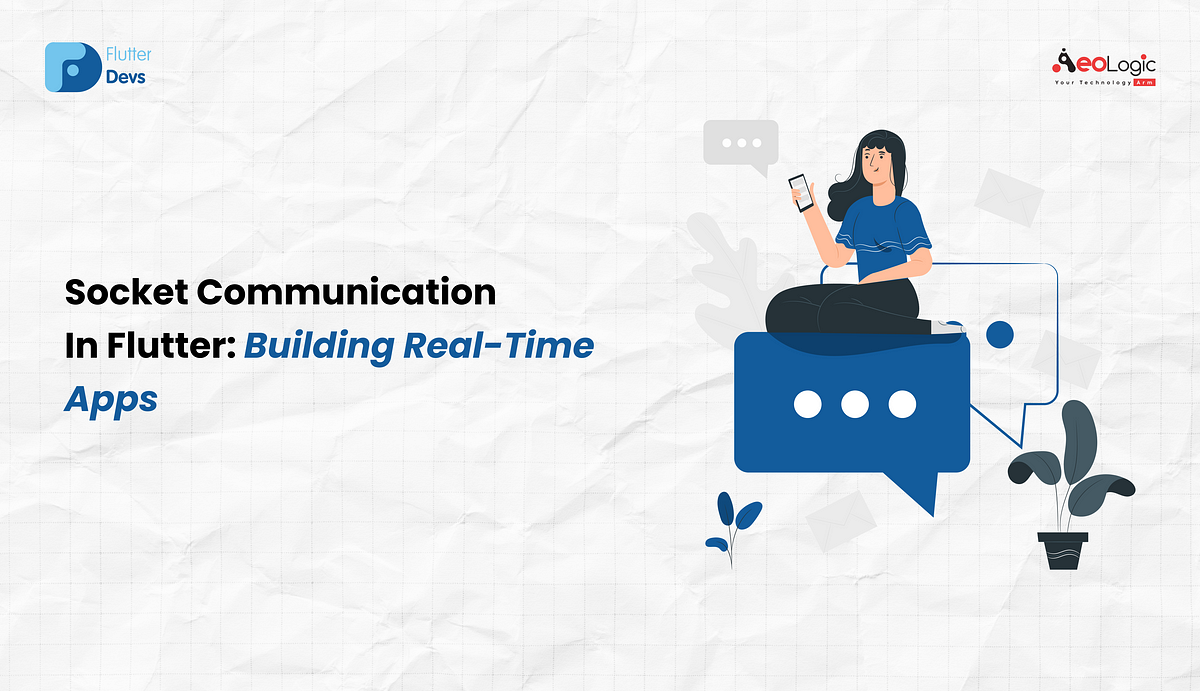Ahsin Irshad
Senior Flutter Developer | Ex. Native Android Developer
Socket Communication in Flutter: Building Real-time Apps – Jan, 2024

What are sockets?
Sockets are communication endpoints used to establish a connection between two computers or devices over a network. They facilitate bidirectional data flow, allowing processes on different machines to exchange information. Sockets provide a standard mechanism for processes running on separate devices to communicate, irrespective of the underlying hardware, operating systems, or programming languages.
There are two types of sockets:
- Server Socket: A server socket waits for incoming connections from clients. It listens on a specific port and, when a client attempts to connect, it establishes a communication channel with that client.
- Client Socket: A client socket initiates a connection to a server socket. It specifies the IP address and port of the server it wants to connect to. Once the connection is established, the client and server can exchange data.
Sockets are commonly used for various network applications, including web browsing, email communication, file transfers, and real-time applications such as online gaming and live chat.
In Flutter, the establishment of socket connections is made possible through different packages, with the web_socket_channel package emerging as a favored option among developers. The web_socket_channel package in Flutter serves as a valuable tool for incorporating WebSocket connections into applications. This package offers StreamChannel wrappers, ensuring compatibility across platforms. It provides a unified WebSocketChannel API, a versatile implementation communicating over a foundational StreamChannel. Additionally, it includes wrappers for both dart:io WebSocket class and dart:html WebSocket class, facilitating seamless integration for both server-side and client-side WebSocket communication.
Here are a few scenarios where
web_socket_channelproves to be beneficial:
1. Real-time Communication: One of the key advantages of WebSocket channels is their ability to facilitate real-time communication. Traditional HTTP requests involve a request-response model, where the client sends a request to the server and awaits a response. In contrast, WebSocket channels enable a continuous, two-way flow of data, making them ideal for applications requiring instant updates and responsiveness.
2. Persistent Connection: Unlike HTTP, which relies on multiple request-response cycles, WebSocket channels maintain a persistent connection. Once established, this connection remains open, allowing for seamless and efficient data transmission between the client and server. This persistent connection minimizes latency and reduces the overhead associated with repeatedly establishing new connections.
3. Bi-Directional Data Flow: WebSocket channels support bi-directional data flow, meaning both the client and server can send data independently of each other. This bidirectional communication is invaluable for applications where real-time updates or instant notifications are essential, such as chat applications, live feeds, and collaborative tools.
4. Implementation with web_socket_channel: In Flutter, the web_socket_channel package simplifies the integration of WebSocket channels into applications. It provides a high-level API for creating WebSocket channels, sending and receiving messages, and handling connection events. By using the IOWebSocketChannel or HtmlWebSocketChannel, developers can seamlessly incorporate WebSocket functionality into both mobile and web applications.
5. Handling Messages with StreamBuilder: Flutter developers often leverage the widget to efficiently manage incoming data from a WebSocket channel. This widget allows for dynamic UI updates based on the data stream, ensuring the application’s interface reflects real-time changes. By combining WebSocket channels StreamBuilder, developers can create responsive and interactive user experiences. This is what we’re going to use in our below-demonstrating project.
6. Security Considerations: While WebSocket channels offer powerful capabilities, developers must be mindful of security considerations. Implementing secure WebSocket connections (wss://) with proper encryption helps protect sensitive data from potential threats. Additionally, ensuring that server-side WebSocket implementations adhere to best security practices is essential for safeguarding the overall application.
Let’s move further to a simple demonstrating project that will help you understand Websocket channels even more easily.
Add the `web_socket_channel` package to your `pubspec.yaml` file:
dependencies:
web_socket_channel: ^2.4.1
Run `flutter pub get` to install the package.
Below is the main.dart file of the project:
void main() => runApp(const MyApp());
class MyApp extends StatelessWidget {
const MyApp({Key? key});
@override
Widget build(BuildContext context) {
return MaterialApp(
debugShowCheckedModeBanner: false,
home: MyHomePage(
channel: IOWebSocketChannel.connect(“ws://echo.websocket.org”),
),
);
}
}
As observed, we start by initializing our WebSocket channel at the outset. We utilize a convenient testing endpoint server, which is freely available for testing WebSocket and Server-Sent Events (SSE) clients effortlessly.
This server is specifically designed for testing HTTP proxies and clients, echoing details about HTTP request headers and bodies back to the client. It provides support for both WebSockets and server-sent events, simplifying the process of working with these technologies.
The endpoint is https://echo.websocket.org/
Here is the code snippet where we are actively streaming real-time data through the channel —
StreamBuilder(
stream: widget.channel.stream,
builder: (context, snapshot) {
return Padding(
padding: const EdgeInsets.all(20.0),
child: Center(
child: Stack(
children: [
BubbleWidget(
key: _bubbleKey,
text: snapshot.data ?? '',
),
],
),
));
},
)
WebSocket channel enables real-time data exchange, making it ideal for applications requiring instant updates, such as chat applications, live notifications, and collaborative editing. With web_socket_channel in Flutter, developers can easily implement WebSocket communication, ensuring efficient and responsive data transfer between the client and server in their applications. Exactly what we’re going to see in this project.
Let’s delve deeper. Here, we’ve got a function responsible for dispatching our messages to the WebSocket channel’s server —
void _sendMessage() {
if (textController.text.isNotEmpty) {
try {
widget.channel.sink.add(textController.text);
} catch (e) {
print("Error: $e");
}
setState(() {});
textController.clear();
}
}
We utilize a TextEditingController to capture user messages from the text field. These messages are then sent to our server through the WebSocket channel.
Hooray! Our project is done. Now, let’s examine the final output.
After executing the demonstration project, we obtain…
#Socket #Communication #Flutter #Building #Realtime #Apps #Jan #Ahsin #Irshad
